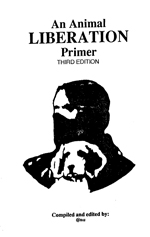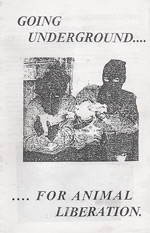» Next Entries
The Archives
-
One-off publications
The Liberator
04.27.11 | PermalinkThe Liberator (1988, San Bernadino, CA. USA.)
In the 1970s, a small group of activists in England decided that animal abuse was so intrinsic to their society, and so protected by the courts and law enforcement, that anonymous, illegal activity was the only surefire way to directly prevent the horrors taking place in slaughterhouses, labs, and killing fields. They began to take the personal initiative to raid and sabotage places where the victimization of animals occurred, but how could they spread their message and tactics? With mainstream media treating them either as misguided nutcases or vicious criminals, and with national animal organizations disavowing their actions, they needed a mechanism to defend their tactics and share their views. The answer was the Animal Liberation Supporters Group, more commonly known as “The SG.” The SG soon took on the responsibility of printing newsletters, conducting press interviews, and raising funds and support for imprisoned activists. Soon, other supporters groups blossomed internationally, and eventually one took off in a small town in Southern California.
The Liberator was a publication of the Animal Liberation Front Support Group of America, an organization with a storied history that included FBI harassment, raids, and internal conflict. This inaugural issue was largely produced by Rod Coronado and Todd Meszaros, and the aesthetics of the issue reflect a bit of the punk influence that the two of them embraced. The design is busy, but also packed with information, press clipping, letters, debates, a timeline of US actions, and historically important letters from figures such as ALF co-founder Ronnie Lee. The centerfold is gorgeous, and it, and many of the other images contained inside were heavily borrowed and reprinted by other magazines.
The mission of the ALF SG of America was to vocally support and defend the ALF, to unify supporters of underground animal activism, to educate the public as to need and rationale of direct action, to encourage implementation of clandestine tactics, to provide a legal defense fund for imprisoned or arrested ALF activists, and to raise funds for all of the above. They did this at a time when dozens of labs across the country were being raided, thousands of people were protesting for animal rights, and the US seemed to be on the cusp of a mass movement for non-humans. The Liberator documented these efforts and is a classic piece of animal liberation history.
…
-
One-off publications
An Animal Liberation Primer, 2nd and 3rd Editions
04.17.11 | PermalinkAnimal Liberation Primer, 2nd and 3rd editions. (Publishing date unknown, materials compiled from England, the United States, and Canada)
Groups operating outside the confines of the law, especially those who utilize a leaderless resistance model, often resort to self published manuals to spread ideology and practical advice on tactics. For the Animal Liberation Front, the Animal Liberation Primer series was the equivalent of the Irish Republican Army’s volunteer handbook. Spread far and wide by sympathetic activists, touring punk bands, and ALF supporters groups, this tiny guide put the power of direct action into the hands of thousands of people.
The Primer focused on security culture, direct action philosophy, tactical decision making between animal rescues and economic sabotage, and more direct how-to directions. Many of the instructions contained in this edition had to be redacted from our archive in order to comply with federal laws on distributing information detailing how to commit arson. Other than standard warnings against lighting fires which might harm animals, including humans, little attention was paid to the long term implications of burning down buildings, including the additional resources available to law enforcement to slow a burgeoning movement for animal liberation. While not ignoring the issue of consequences completely, it was a failure of the authors to not dedicate more space to examining the long term effects of a direct action campaign on public support, repression, and momentum. That being said, one would expect a greater degree of heavy handed, ideologically rigid language from a zine such as this. Fortunately the tone remains determined and confident without titling towards cultish.


…
-
One-off publications
Going Underground for Animal Liberation
04.05.11 | PermalinkGoing Underground for Animal Liberation (England, 1993)
The early part of the 1990s saw a number of small booklets written anonymously by participants in illegal direct action and distributed widely to sympathizers “above ground.” These booklets varied in quality and ranged from interviews with people who had undertook small scale sabotage, to more theoretical works that dealt with the direction the authors felt the movement should go. Going Underground follows that latter formula, and offers thoughts on the meaning of animal liberation, the value of direct action, and the security measures one should practice before undertaking that path. The contents of this small zine were largely applicable to a specific time period and geographical place, but relevant ideas are sprinkled here and there inside its pages.
…
» Next Entries






